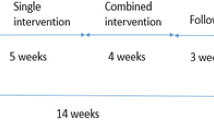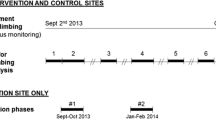Abstract
Environmental modifications have been shown to increase short-term stair use, longer-term success is unclear. This study assessed the 2-year effectiveness of an environmental intervention promoting worksite stair use. We assessed stair use at work by means of self-reports and infrared beam counters (which send a safe and invisible beam of infrared light from one side of a stairwell to a reflector on the other side; when an individual uses the stairs, the infrared beam is disrupted and an instance of stair use is recorded) at six worksites (three intervention, three control) in a group randomized, controlled worksite weight-gain prevention trial in Minneapolis/St. Paul, MN. Intervention modifications were signs encouraging stair use, music, and art posters in stairwells. We collected data before environmental modifications (2006–2007) and at the end of the 2-year intervention (2008–2009). The intervention had a significant positive effect on stair use measured both objectively and via self-report, with greatest increases reported among those participants who used the stairs least at baseline. Following 2-years of continuously-maintained stairwell modifications, increases in both objectively-measured and self-reported stair use were significantly larger at intervention than control worksites. Study findings suggest that the positive impact of environmental modifications on stair use persist over a longer time period than has been previously demonstrated. Results also indicate that infrequent stair users may be most amenable to the behavior changes encouraged by these environmental enhancements.

Similar content being viewed by others
References
Andersen, R. E., Franckowiak, S. C., Snyder, J., Bartlett, S. J., & Fontaine, K. R. (1998). Can inexpensive signs encourage the use of stairs? Results from a community intervention. Annals of Internal Medicine, 129(5), 363–369.
Ballinger, G. A. (2004). Using generalized estimating equations for longitudinal data analysis. Organizational Research Methods, 72(2), 127–150. doi:10.1177/1094428104263672.
Blamey, A., Mutrie, N., & Aitchison, T. (1995). Health promotion by encouraged use of stairs. British Medical Journal, 311(7000), 289–290.
Boutelle, K. N., Jeffery, R. W., Murray, D. M., & Schmitz, M. K. (2001). Using signs, artwork, and music to promote stair use in a public building. American Journal of Public Health, 91(12), 2004–2006.
Brownell, K. D., Stunkard, A. J., & Albaum, J. M. (1980). Evaluation and modification of exercise patterns in the natural environment. American Journal of Psychiatry, 137(12), 1540–1545.
Brownson, R. C., Baker, E. A., Housemann, R. A., Brennan, L. K., & Bacak, S. J. (2001). Environmental and policy determinants of physical activity in the United States. American Journal of Public Health, 91(12), 1995–2003.
Bungum, T., Meacham, M., & Truax, N. (2007). The effects of signage and the physical environment on stair usage. Journal of Physical Activity and Health, 4(3), 237–244.
Coleman, K. J., & Gonzalez, E. C. (2001). Promoting stair use in a US-Mexico border community. American Journal of Public Health, 91(12), 2007–2009.
Crespo, N. C., Sallis, J. F., Conway, T. L., Saelens, B. E., & Frank, L. D. (2011). Worksite physical activity policies and environments in relation to employee physical activity. American Journal of Health Promotion, 25(4), 264–271. doi:10.4278/ajhp.081112-QUAN-280.
Dunn, A. L., Andersen, R. E., & Jakicic, J. M. (1998). Lifestyle physical activity interventions. History, short- and long-term effects, and recommendations. American Journal of Preventive Medicine, 15(4), 398–412.
Engbers, L. H., van Poppel, M. N., & van Mechelen, W. (2007). Modest effects of a controlled worksite environmental intervention on cardiovascular risk in office workers. Preventive Medicine, 44(4), 356–362. doi:10.1016/j.ypmed.2006.11.005.
Eves, F. F., Masters, R. S., McManus, A., Leung, M., Wong, P., & White, M. J. (2008). Contextual barriers to lifestyle physical activity interventions in Hong Kong. Medicine and Science in Sports and Exercise, 40(5), 965–971. doi:10.1249/MSS.0b013e3181659c68.
Eves, F. F., Webb, O. J., & Mutrie, N. (2006). A workplace intervention to promote stair climbing: Greater effects in the overweight. Obesity, 14(12), 2210–2216. doi:10.1038/oby.2006.259.
Flegal, K. M., Carroll, M. D., Ogden, C. L., & Curtin, L. R. (2010). Prevalence and trends in obesity among US adults, 1999–2008. The Journal of the American Medical Association, 303(3), 235–241. doi:10.1001/jama.2009.2014.
Ford, M. A., & Torok, D. (2008). Motivational signage increases physical activity on a college campus. Journal of American College Health, 57(2), 242–244. doi:10.3200/JACH.57.2.242-244.
Goetzel, R. Z., & Ozminkowski, R. J. (2008). The health and cost benefits of work site health-promotion programs. Annual Review of Public Health, 29, 303–323. doi:10.1146/annurev.publhealth.29.020907.090930.
Haskell, W. L., Lee, I. M., Pate, R. R., Powell, K. E., Blair, S. N., Franklin, B. A., et al. (2007). Physical activity and public health: Updated recommendation for adults from the American College of Sports Medicine and the American Heart Association. Medicine and Science in Sports and Exercise, 39(8), 1423–1434. doi:10.1249/mss.0b013e3180616b27.
Horton, N. J., & Lipsitz, S. R. (1999). Review of software to fit generalized estimating equation regression models. The American Statistician, 53, 160–169. doi:10.1002/(SICI)1097-0258(19990130)18:2<213:AID-SIM999>3.0.CO;2-E.
Kerr, J., Eves, F., & Carroll, D. (2000). Posters can prompt less active people to use the stairs. Journal of Epidemiology and Community Health, 54(12), 942.
Kerr, J., Eves, F., & Carroll, D. (2001a). Encouraging stair use: Stair-riser banners are better than posters. American Journal of Public Health, 91(8), 1192–1193.
Kerr, J., Eves, F., & Carroll, D. (2001b). Six-month observational study of prompted stair climbing. Preventive Medicine, 33(5), 422–427. doi:10.1006/pmed.2001.0908.
Kerr, J., Eves, F. F., & Carroll, D. (2001c). The influence of poster prompts on stair use: The effects of setting, poster size and content. British Journal of Health Psychology, 6(Part 4), 397–405. doi:10.1348/135910701169296.
Kerr, J., Eves, F. F., & Carroll, D. (2001d). Can posters prompt stair use in a worksite environment? Journal of Occupational Health, 43, 205–207.
Kerr, N. A., Yore, M. M., Ham, S. A., & Dietz, W. H. (2004). Increasing stair use in a worksite through environmental changes. American Journal of Health Promotion, 18(4), 312–315.
Lee, I. M., Djousse, L., Sesso, H. D., Wang, L., & Buring, J. E. (2010). Physical activity and weight gain prevention. The Journal of the American Medical Association, 303(12), 1173–1179. doi:10.1001/jama.2010.312.
Linde, J. A., Nygaard, K. E., MacLehose, R. F., Mitchell, N. R., Harnack, L. J., Cousins, J. M., et al. (2012). HealthWorks: Results of a multi-component group-randomized worksite environmental intervention trial for weight gain prevention. International Journal of Behavioral Nutrition and Physical Activity, 9, 14. doi:10.1186/1479-5868-9-14.
Linnan, L., Bowling, M., Childress, J., Lindsay, G., Blakey, C., Pronk, S., et al. (2008). Results of the 2004 National Worksite Health Promotion Survey. American Journal of Public Health, 98(8), 1503–1509. doi:10.2105/AJPH.2006.100313.
Marshall, A. L., Bauman, A. E., Patch, C., Wilson, J., & Chen, J. (2002). Can motivational signs prompt increases in incidental physical activity in an Australian health-care facility? Health Education Research, 17(6), 743–749.
Matson-Koffman, D. M., Brownstein, J. N., Neiner, J. A., & Greaney, M. L. (2005). A site-specific literature review of policy and environmental interventions that promote physical activity and nutrition for cardiovascular health: What works? American Journal of Health Promotion, 19(3), 167–193.
Norton, E. C., Garfinkel, S. A., McQuay, L. J., Heck, D. A., Wright, J. G., Dittus, R., et al. (1998). The effect of hospital volume on the in-hospital complication rate in knee replacement patients. Health Services Research, 33(5 Pt 1), 1191–1210.
Porter, E. (2006, March 2, 2006). Women in workplace—Trend reversing/study: They may be unable to fit more in, New York Times.
Sallis, J. F., & Saelens, B. E. (2000). Assessment of physical activity by self-report: Status, limitations, and future directions. Research Quarterly for Exercise and Sport, 71(2 Suppl), S1–S14.
Teh, K. C., & Aziz, A. R. (2002). Heart rate, oxygen uptake, and energy cost of ascending and descending the stairs. Medicine and Science in Sports and Exercise, 34(4), 695–699.
Troiano, R. P., Berrigan, D., Dodd, K. W., Masse, L. C., Tilert, T., & McDowell, M. (2008). Physical activity in the United States measured by accelerometer. Medicine and Science in Sports and Exercise, 40(1), 181–188. doi:10.1249/mss.0b013e31815a51b3.
Webb, O. J., & Eves, F. F. (2007). Promoting stair climbing: Intervention effects generalize to a subsequent stair ascent. American Journal of Health Promotion, 22(2), 114–119.
Webb, O. J., Eves, F. F., & Kerr, J. (2011). A statistical summary of mall-based stair-climbing interventions. Journal of Physical Activity & Health, 8(4), 558–565.
Zeger, S. L., & Liang, K. Y. (1986). Longitudinal data analysis for discrete and continuous outcomes. Biometrics, 42(1), 121–130.
Zeger, S. L., Liang, K. Y., & Albert, P. S. (1988). Models for longitudinal data: A generalized estimating equation approach. Biometrics, 44(4), 1049–1060.
Acknowledgments
This study was funded by National Institutes of Health Grant 1 R01 DK067362 (R. W. Jeffery, PI); ClinicalTrials.gov identifier: NCT00708461, “Environmental Intervention for Weight Gain Prevention (HealthWorks).”
Conflict of interest
The authors have no conflict of interest to disclose.
Author information
Authors and Affiliations
Corresponding author
Electronic supplementary material
Below is the link to the electronic supplementary material.
Rights and permissions
About this article
Cite this article
Graham, D.J., Linde, J.A., Cousins, J.M. et al. Environmental Modifications and 2-Year Measured and Self-reported Stair-Use: A Worksite Randomized Trial. J Primary Prevent 34, 413–422 (2013). https://doi.org/10.1007/s10935-013-0323-2
Published:
Issue Date:
DOI: https://doi.org/10.1007/s10935-013-0323-2




